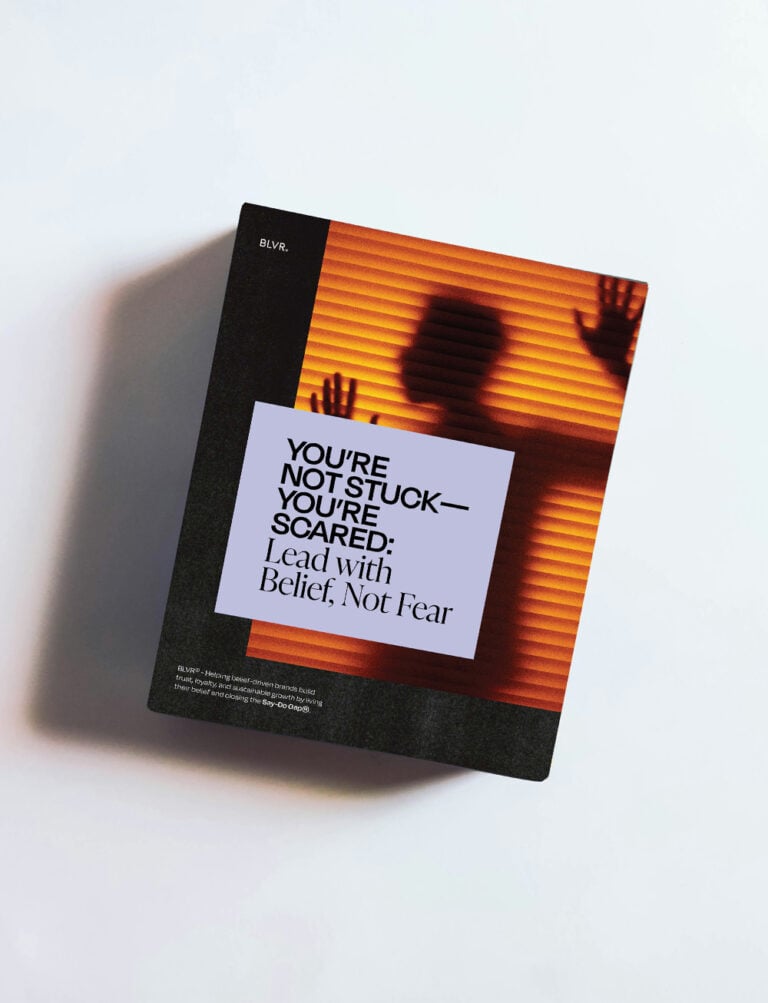
Business Branding / BY Scott Hancock
Fear vs. Belief: What’s Driving Your Leadership?
Published On 02.11.2025
Article
Every Decision Comes Down to One Thing
Every decision you make as a leader is driven by one of two forces: fear or belief.
Fear whispers:
- “What if this doesn’t work?”
- “What if we alienate customers?”
- “What if we lose everything we’ve built?”
Belief asks:
- “What if this is the decision that changes everything?”
- “What if this risk leads to exponential growth?”
- “What if this bold move inspires the trust and loyalty we’ve been craving?”
The truth is fear convinces you to protect the status quo, while belief inspires you to redefine it. But here’s the uncomfortable reality: fear-driven leadership doesn’t protect your brand—it paralyzes it.
The Trap of Fear-Driven Leadership
Fear doesn’t announce itself loudly. It hides behind excuses like “We’re being cautious” or “Let’s wait for the right time.” But when fear drives your decisions, the outcomes are predictable—and costly.
Missed Opportunities
While you wait for perfect conditions, your competitors are innovating, taking risks, and winning market share.
Diluted Identity
Fear leads to playing it safe. You start avoiding bold moves, and suddenly, your brand is indistinguishable from everyone else.
Eroded Trust
When your actions are hesitant or inconsistent, customers and employees start to doubt your conviction. And trust is one of the hardest things to rebuild.
Case Study: Kodak’s Fear of Reinvention
Kodak once dominated the photography industry. But when digital cameras emerged, Kodak hesitated. They feared cannibalizing their profitable film business and alienating loyal customers. Instead of leading the charge into the digital age, they clung to the past.
Meanwhile, brands like Canon and Sony leaned into digital innovation, and Kodak’s relevance evaporated.
Kodak wasn’t killed by technology—it was killed by fear of change. Their hesitation allowed bolder competitors to leap ahead, leaving Kodak as a cautionary tale for leaders who cling to comfort instead of chasing conviction.
The Power of Belief-Driven Leadership
Belief-driven leadership doesn’t just inspire your team and customers—it transforms your brand. Leaders who make decisions rooted in belief, not fear, enjoy three key advantages.
Conviction Fuels Bold Action
When you’re grounded in your brand’s belief, you can make bold, decisive moves—even when they’re risky.
Belief Inspires Loyalty
Customers and employees rally behind leaders who stay true to their values, building trust and deepening loyalty.
Belief Redefines Markets
Fearful brands adapt to survive. Belief-driven brands innovate to thrive, setting new standards in their industries.
Case Study: Patagonia’s Belief in Protecting the Planet
Patagonia’s success isn’t just about selling outdoor gear—it’s built on a core belief: “A love of wild and beautiful spaces demands participation in the fight to save them.” Instead of chasing fast fashion trends or maximizing short-term profits, Patagonia has made bold, belief-driven decisions that reinforce its commitment to environmental responsibility.
Here’s how belief-driven leadership shaped their success:
- Environmental Activism: Patagonia donates 1% of sales to environmental causes, fights for public land protections, and even sued the U.S. government over conservation issues—putting their belief into action.
- Reducing Consumption: In a bold move, they launched the “Don’t Buy This Jacket” campaign, actively discouraging overconsumption and encouraging customers to repair rather than replace their gear.
- Employee-First Culture: Their internal culture reflects their belief—offering paid activism leave, on-site childcare, and a work environment that supports a purpose-driven lifestyle.
The result? Patagonia didn’t just build a customer base—it built a movement. By leading with belief, they’ve become one of the world’s most trusted and belief-driven brands, proving that standing for something bigger than profit is the path to lasting impact.
How to Lead with Belief, Not Fear
Fear will always exist. The key is ensuring it doesn’t make your decisions for you. Here’s how to shift from fear-driven hesitation to belief-driven leadership.
1. Identify Where Fear Is Holding You Back
Fear often shows up as hesitation, over-analysis, or clinging to outdated strategies. Spotting it is the first step to overcoming it.
Reflection Questions:
- What bold opportunities have we missed because we hesitated?
- Where are we making decisions out of fear of change or failure?
- If fear weren’t in the equation, what would we do differently?
Example:
A small design agency realized fear was holding them back from pitching their dream clients. They reframed their approach, leading with their belief in creative transformation and embracing bold outreach. The result? They landed high-profile clients who resonated with their conviction.
2. Reconnect with Your Brand’s Belief
Your belief is your north star. It’s what gives your brand purpose and clarity. When you lead with belief, bold decisions feel less like risks and more like inevitabilities.
Action Steps:
- Revisit Your Purpose: Why does your brand exist beyond making money?
- Align Leadership: Ensure your leadership team understands and embodies your core belief.
- Audit Recent Decisions: Have they aligned with your belief or been driven by fear?
Example:
Notion, the productivity software company, stays true to its belief in creating tools that empower users to work their way. Instead of adding unnecessary complexity to compete with larger platforms, they focus on simplicity and customization, reinforcing their purpose at every turn.
3. Take One Bold, Visible Action
Customers and employees don’t expect perfection, but they do expect action. Start small, but make it bold and visible.
How to Take Action:
- Identify an area where fear has held your brand back.
- Take a deliberate step that aligns with your belief.
- Share your journey openly—transparency inspires trust.
Example:
Gravity Payments made a bold, belief-driven move when CEO Dan Price cut his own salary from $1.1 million to $70,000 so every employee could earn a living wage. Instead of prioritizing executive wealth, the company put income equality at its core, boosting employee satisfaction and retention and even tripling revenue—proving that purpose-driven leadership pays off.
The ROI of Belief-Driven Leadership
When you lead with belief instead of fear, the results ripple through your business.
- Customer Retention: Belief-driven brands inspire deep loyalty, reducing churn and increasing advocacy.
- Employee Engagement: Teams are energized by leaders who embody conviction, fostering innovation and commitment.
- Market Differentiation: While others play it safe, belief-driven brands carve out unique, memorable positions.
Ask Yourself: What’s Driving Your Leadership Today?
- Are your decisions rooted in fear or belief?
- What bold move could you make if fear weren’t in the equation?
- How can you align your leadership with your brand’s core belief?
The future belongs to brands that lead boldly, inspire trust, and take meaningful action. Which path will you choose?
LEAD WITH BELIEF
NOT FEAR
The boldest brands—Dr. Bronner’s, Patagonia, Liquid Death—don’t play it safe. They lead with conviction. This guide breaks down how to close the Say-Do Gap®, align your brand with belief, and build lasting trust.
See how fearless brands win.

About the Author

Scott Hancock
Partner / CEO
Scott Hancock is a thought leader in belief-driven branding and an expert in closing the Say-Do Gap®—the critical divide between what brands say and what they actually do. As CEO of BLVR®, Scott has pioneered a belief-led approach that helps organizations transform their core conviction into bold actions that inspire trust, loyalty, and market leadership.
With a reputation for pushing brands to go beyond surface-level promises, Scott’s work has been recognized by AdWeek, Forbes, and Fast Company for its fearless creativity and impactful results. His leadership has empowered BLVR® to become a trusted partner for purpose-driven brands seeking to align their actions with their core belief and create lasting change.
© BLVR
SD / CA




